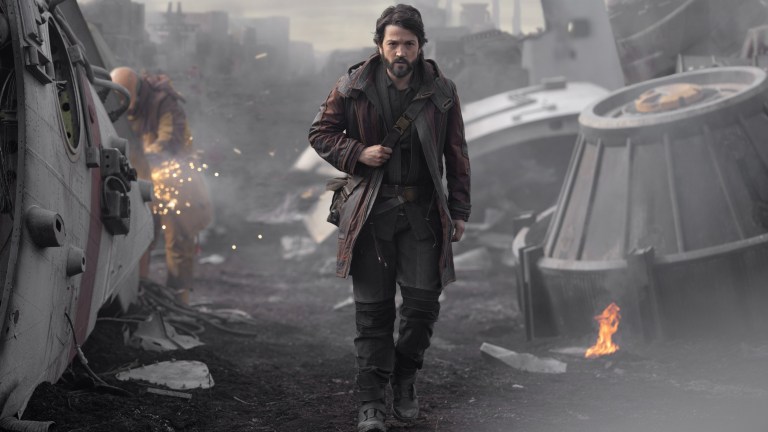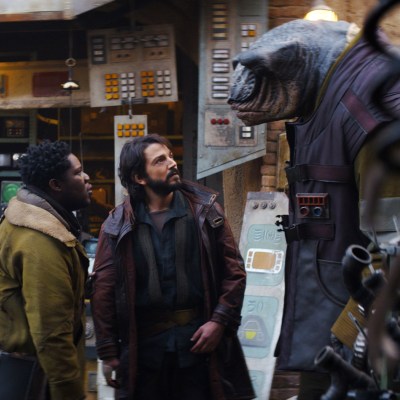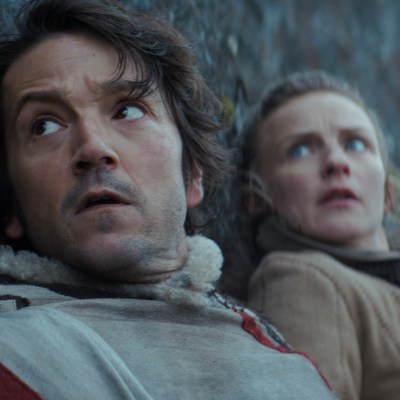Star Wars: Andor Episode 1-3 Review
The most patient Star Wars show ever is strangely unburdened by the one thing that could be holding it back.

This Star Wars: Andor review contains spoilers.
As wonderful as Diego Luna was as Cassian Andor in Rogue One: A Star Wars Story back in 2016, the feeling of seeing him on screen again in 2022 in Star Wars: Andor can’t be described as nostalgia. Yes, there’s a pleasant sense of familiarity when he walks onto the first scene, but because nearly everything we learn about Cassian on the show is brand-new, and his surroundings are utterly unfamiliar, there’s nothing about the series that’s trying to recreate any feelings we had about Rogue One. Instead, Andor is playing an entirely different game than any Star Wars story on screen.
Comparing Andor to Rogue One isn’t really useful because Rogue One was a one-off movie and Andor is like a great, quiet Star Wars novel turned into a TV series. Even though its setting is spun-out from complex Star Wars lore, Andor feels like the most anti-nostalgia Star Wars project ever made, and as a result, the most refreshing story from this galaxy in years.
The first three episodes of Andor were dropped all at the same time on Disney+ and you can see why. These first three stories are only “episodes” from a technical point-of-view. They each have opening and closing credit, but much like in the ‘90s, where splashy two-hour sci-fi series premieres were later broken up into two-part episodes for syndication, it makes the most sense to view the first three episodes of Andor as a compact pilot movie for the series. Some folks will say the first three episodes are slow and that the pacing is off. But if you just think of these first three episodes as one long episode, you’ll be shocked by how fast things happen and how much world-building is efficiently baked into this premiere.
The present-tense day is primarily confined to two planets: Ferrix and Morlana One, both part of a “corporate sector” of the galaxy guarded by a private security force called Preox-Morlana. Andor goes for casual sci-fi realism with these locations in that hopping between these two planets is presented as just a short commute. The series opens with Cassian on Morlana One, in what the show directly (and surprisingly) describes as a brothel. He’s looking for his sister, who we later learn — through a series of flashbacks on the planet Kenari — was separated from him when they were very young. Because Cassian isn’t yet a Rebel spy, he doesn’t have stormtroopers hot on his trail. Instead, after leaving the brothel, he gets into a back alley scuffle with two low-level Pre-Mor employees. One of them is accidentally killed in the fight, and in order to cover his tracks, Cassian executes the other guy.
This opening moment is reminiscent of the scene early in Rogue One, in which Cassian killed one of his informants in order to protect the secrecy of his mission, but with one crucial difference. In Rogue One, Cassian was blasting someone for tactical reasons, in service of a higher cause. In Andor, he’s broke and desperate. From the opening minutes, Andor establishes its more realistic and literary approach. Cassian owes everyone money, is spinning several lies, and, after this inciting incident, has painted himself into a corner.
A cynical viewer would say that it takes three episodes for Cassian to join the Rebellion, but the way the show is written, his reasons for eventually leaving Ferrix with Rebellion-recruiter Luthen Rael (Stellan Skarsgård) are simply the consequences of his own mistakes. In most Star Wars narratives, the fish-out-of-water audience surrogates (Rey, Luke Skywalker) are transported from their dead-end day-to-day and instantly into the thick of the action. Although Andor is still subtly borrowing from this hero’s journey format — and in episode 3 Cassian resists the “call to adventure” as much as he can — there’s a grounded approach to this story. Joining the Rebellion wouldn’t happen overnight in real life, and if there was an organized revolt against a massive galactic dictatorship, what that would look like granularly would be much different than the big space battles and daring missions of the Star Wars films. Cassian isn’t thrust into a bigger story because the story forces him to, instead, his character is the story.
In many Star Wars stories, character development tends to be a lot like the way planets are depicted in this fictional galaxy. Tatooine is a desert planet, and Anakin Skywalker is a quick-tempered hotshot. Hoth is a snow planet and Finn is a big-hearted idealist. You get it. Although we all love Star Wars because of the characters, the films have a tendency to flatten them, which, arguably, was what George Lucas was going for when he created all of this. The vast majority of characters in Star Wars are archetypes, which in a sense, makes them the opposite of what literary characters are in novels.
Andor’s greatest achievement is that it moves away from one-note archetypes and closer toward the multifaceted characters of literature. In the first three episodes of Andor, Luna plays the titular character with a variety of shades. Cassian is thoughtful, arrogant, duplicitous, heroic, manipulative, and again, desperate. Describing him quickly and glibly (Han Solo is a space pirate with a heart of gold!) doesn’t work here. For other types of pop fiction, this sort of thing is kind of expected. But for Star Wars, it’s a revelation.
Throughout these first three episodes, we learn all about Andor’s complicated relationships with the workers and denizens of Ferrix. His broken-down droid B2EMO constantly needs a charge and stutters in a decidedly Max Headroom-style. He nurtures a tense relationship with Bix (Adria Arjona), who helps Cassian get in contact with a “buyer” for a specific piece of stolen Imperial merchandise. It’s heavily implied that Cassian and Bix have a dating history, a fact made complicated by her new boyfriend Timm (James McArdle), who, eventually, is the catalyst that leads to the Pre-Mor authorities figuring out that it was Cassian who killed those two dudes on Morlana One. Because Timm hates that Bix still does Cassian favors, he tips off the Pre-Mor cops, who come gunning for Cassian in the third episode.
All of this is made more interesting by the fact that the Pre-Mor soldiers are led by Syril Karn (Kyle Soller), an overly-zealous employee who, against the orders of his superior, decides to personally try to bring Cassian to justice. Soller plays Karn as a kind of high school Republican fused with Buster from Arrested Development. He’s a frightening character obsessed with what he perceives to be his higher calling, when really, in the grand scheme of Star Wars, he’s basically the Empire’s version of a gas station shift leader. Karn’s is presented as another complex character, and wherever the show is taking him will be fascinating to watch.
While a series of flashbacks teases out details of Andor’s mysterious childhood on Kenari, everything culminates in episode 3, as Karn and his goon squad arrive on Ferrix to arrest Cassian. Luthen rolls in under the pretense of buying the stolen merchandise, but really wants to recruit Andor to fight in the Rebellion. The idea that Luthen went to all this trouble to recruit one guy on a random planet is a bit much, and perhaps the only beat in these episodes that feels a bit incongruous with the rest of its character-driven realism. Then again, future episodes could indicate Luthen has other motives that we’re not aware of yet. But by the time Cassian and Luthen are riding a speeder bike and blasting their way to safety, you hardly care.
The slow-burn of Andor’s first three episodes rewards the audience with a thrilling escape sequence, which is under-cut with the final flashback. Turns out Cassian was adopted by Maarva (Fiona Shaw), who, we learn, flew him off the planet after running into him during a scavenging run on Kenari. It’s a touching ending, which makes good use of the protracted flashbacks, and makes you more curious about Andor’s childhood than perhaps you were before. But by the time you’re emotionally processing all of that, Luthen slams his ship into hyperspace.
Although Andor is technically a prequel of a prequel, what makes it wonderful and utterly unique among the pantheon of Star Wars is that for the first time since the original film in 1977, you’re not constantly thinking about other Star Wars stuff. While one could argue that The Mandalorian was similarly self-contained when it debuted in 2019, that’s not really true: at the end of the day, visually, Mando relied on a guy who looked like Boba Fett and a character that was literally a baby version of another Star Wars character we already knew and loved, Yoda. So, calling Mando a departure may have been true in some superficial sense, but the way that series kept hardcore fans and the general public ravenous for more was essentially a fairly transparent Star Wars trick. Visually and aesthetically, the whole series was a remix. This is also true, to varying degrees, of The Book of Boba Fett and Obi-Wan Kenobi, both which are chock-full of fan service in a way that Andor isn’t. Obi-Wan even pulled its own “Baby Yoda” trick with young Leia (Vivien Lyra Blair). And while all of these shows are great in their own ways, they almost feel like they’re in a different tonal universe from Andor.
So far, Andor is the first Star Wars thing outside of the comics and novels that truly delivers on the oft-repeated notion that this fictional universe is much bigger than we see on the big screen. We’re actually getting into the nitty-gritty of what real people would be like in this galaxy if they weren’t Jedi, clone troopers, or bounty hunters. And in a world where people are named “Skywalker” and “Darth Maul,” having a story this grounded is a huge risk. Here’s hoping the gamble pays off.
Star Wars: Andor is streaming now on Disney+.


